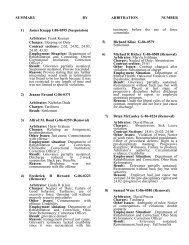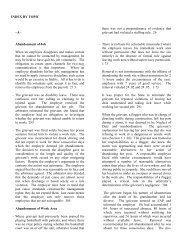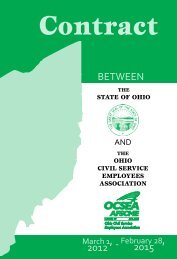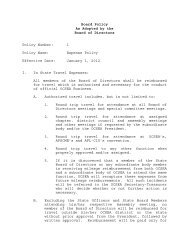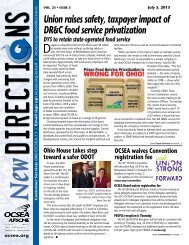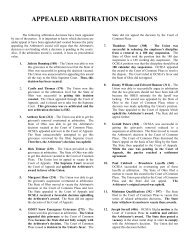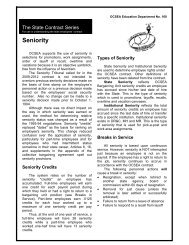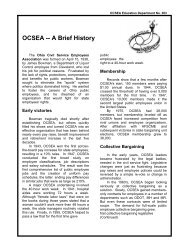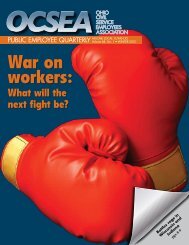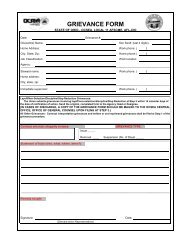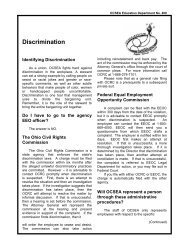by Contract Number (PDF) - OCSEA
by Contract Number (PDF) - OCSEA
by Contract Number (PDF) - OCSEA
Create successful ePaper yourself
Turn your PDF publications into a flip-book with our unique Google optimized e-Paper software.
The work was not consolidated or redistributed.<br />
The abolishment was illegal. 340<br />
The employer in this case did redistribute the<br />
abolished duties correctly but this does not<br />
complete an analysis of a job abolishment. The<br />
employer must prove in this case its efficiency<br />
argument. The employees who took over the<br />
duties of a Health and Safety Inspector I, the<br />
abolished position, were not shown to be<br />
properly trained or knowledgeable. The Union’s<br />
introduction of increased citations for not<br />
properly filing accident reports shows how<br />
inefficient this abolishment was; the State did<br />
not prove its case and the abolishment was not<br />
proper. 340<br />
The employer replaced the abolished position’s<br />
duties with the service of an outside private<br />
institution. If the appointing authority decides to<br />
subcontract the work it becomes almost<br />
impossible to show that a lack of work existed<br />
for this position. If the position is transferred,<br />
either internally or externally, it cannot be said to<br />
be permanently deleted. 340<br />
The employer properly abolished the positions of<br />
three Hospital Aide Coordinator I’s. The work<br />
was distributed to other employees holding<br />
different positions. The fact that one HAC was<br />
working out of her classification prior to the<br />
abolishment reinforces the employer’s argument<br />
that this position was not linger required. The<br />
employer’s need for more direct care staff to<br />
follow a “normalization” program was legitimate<br />
and the abolishments were a way to efficiently<br />
pursue this goal. 340<br />
The arbitrator was unwilling to substitute his<br />
judgment for the employer’s in deciding between<br />
managerial alternatives. 340<br />
The Union can win a particular abolishment<br />
claim without presenting any direct evidence<br />
countering an employer’s efficiency justification.<br />
In doing so, however, the Union faces the<br />
possibility of failing to introduce sufficient<br />
opposing testimony to dissuade a positive<br />
impression created <strong>by</strong> the employer’s testimony.<br />
Preponderance of the evidence, the standard that<br />
the State must establish, is defined <strong>by</strong> Black’s<br />
Law Dictionary as: “It rests with the evidence<br />
which, when fairly considered, produces the<br />
stronger impression, and has the greater weight,<br />
and is more convincing as to its truth when<br />
weighed against the evidence in opposition<br />
thereto.” The arbitrator made the point that it<br />
would be wise for the Union to introduce<br />
evidences that could weigh against the State’s<br />
case. 340<br />
The federal government created established<br />
hiring criteria, and funded job training positions<br />
with in the Ohio Bureau of Employment<br />
Services for Disabled Veterans’ Outreach<br />
Specialists (DVOPS), and Local Veterans’<br />
Employment Representatives (LVERS). The<br />
OBES and Department of Labor negotiated<br />
changes in the locations of these employees<br />
which resulted in layoffs which were not done<br />
pursuant to Article 18. Title 38 of the United<br />
States Code was found to conflict with contract<br />
Article 18. There is no federal statute analogous<br />
to Ohio Revised Code section 4117 which allows<br />
conflicting contract sections to supersede the<br />
law, thus federal law was found to supersede the<br />
contract. As the arbitrator’s authority extends<br />
only to the contract and state law incorporated<br />
into it, the DVOPS’ and LVERS’ claim was held<br />
not arbitrable. Other resulting layoffs were found<br />
to be controlled <strong>by</strong> the contract and Ohio<br />
Revised Code sections incorporated into the<br />
contract (see, Broadview layoff arbitration<br />
#340). The grievance was sustained in part. The<br />
non-federally created positions had not been<br />
properly abolished and the affected employees<br />
were awarded lost wages for the period of their<br />
improper abolishments. 390<br />
Nothing in any of the Article 18 sections .02<br />
through .08 contradict, modify or eliminate the<br />
Five Year Rule. The Arbitrator rejected the<br />
argument that Article 18 supersedes the Ohio<br />
Revised code and the Ohio Administrative Code.<br />
The Article specifically states the ORC and OAC<br />
sections are included. If the parties intended that<br />
Sections 18.02 through 18.05 should completely<br />
supersede the ORC and OAC, the <strong>Contract</strong><br />
would so state. In addition, nowhere is any time<br />
limit stated on these rights. 450 (1992-94<br />
contract)<br />
The burden to demonstrate rationale for job<br />
abolishment and layoff decisions rests on the<br />
Employer. 454 (1992-94 contract)<br />
The Employer fulfilled its burden to demonstrate<br />
the rationale for its job abolishment and layoff<br />
decisions. There was either a lack of work or the<br />
duties had been absorbed <strong>by</strong> other bargaining<br />
unit members. 454 (1992-94 contract)



